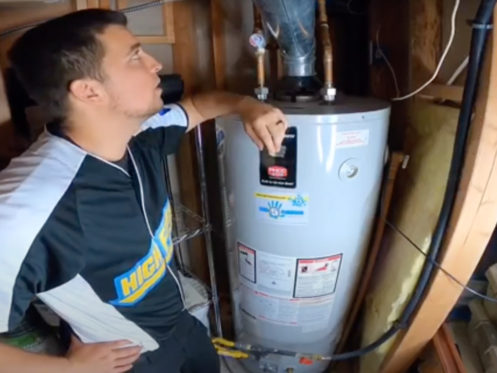Best Practices for Maintaining Your Home's Hot Water System
Best Practices for Maintaining Your Home's Hot Water System
Blog Article
How do you actually feel about Tips For Maintaining Your Hot Water Heater?

Warm water is crucial for everyday comfort, whether it's for a revitalizing shower or cleaning dishes. To guarantee your hot water system runs successfully and lasts much longer, routine maintenance is crucial. This short article provides functional suggestions and understandings on just how to preserve your home's warm water system to prevent disruptions and expensive repair work.
Intro
Maintaining your home's hot water system could seem overwhelming, however with a couple of easy actions, you can ensure it runs smoothly for several years to come. This overview covers every little thing from comprehending your warm water system to do it yourself maintenance ideas and knowing when to employ professional assistance.
Relevance of Preserving Your Hot Water System
Routine upkeep not only prolongs the life-span of your hot water system however additionally guarantees it runs effectively. Ignoring upkeep can result in lowered efficiency, greater energy expenses, and even early failing of the system.
Indications Your Warm Water System Needs Maintenance
Understanding when your warm water system needs interest can protect against major problems. Keep an eye out for signs such as inconsistent water temperature, odd sounds from the heater, or rusty water.
Comprehending Your Warm Water System
Before diving right into maintenance tasks, it's practical to recognize the basic elements of your warm water system. Typically, this includes the water heater itself, pipelines, anode rods, and temperature controls.
Monthly Maintenance Tasks
Regular regular monthly checks can aid catch minor problems prior to they escalate.
Flushing the Hot Water Heater
Flushing your water heater removes sediment buildup, improving efficiency and prolonging its life.
Checking and Replacing Anode Rods
Anode rods prevent corrosion inside the tank. Examining and changing them when broken is critical.
Evaluating and Adjusting Temperature Level Setups
Readjusting the temperature level setups ensures optimum efficiency and safety and security.
Do It Yourself Tips for Upkeep
You can carry out a number of upkeep tasks yourself to keep your hot water system in leading problem.
Looking for Leakages
Regularly evaluate pipelines and links for leakages, as these can bring about water damage and higher costs.
Examining Stress Relief Valves
Evaluating the pressure relief valve ensures it functions appropriately and protects against too much pressure buildup.
Insulating Pipelines
Insulating warm water pipes decreases heat loss and can conserve power.
When to Call a Professional
While do it yourself upkeep is valuable, some problems require specialist competence.
Complex Concerns Calling For Expert Help
Instances include significant leakages, electrical troubles, or if your hot water heater is regularly underperforming.
Regular Expert Maintenance Perks
Professional upkeep can include extensive inspections, tune-ups, and making certain compliance with safety requirements.
Conclusion
Normal maintenance of your home's hot water system is necessary for effectiveness, long life, and expense financial savings. By complying with these tips and recognizing when to seek specialist assistance, you can make certain a trustworthy supply of hot water without unforeseen disruptions.
How to Maintain an Instant Hot Water Heater
Before tinkering with your hot water heater, make sure that it’s not powered on. You also have to turn off the main circuit breaker and shut off the main gas line to prevent accidents. Also turn off the water valves connected to your unit to prevent water from flowing into and out of the appliance. 2. When you’re done, you have to detach the purge valves’ caps. These look like the letter “T†and are situated on either side of the water valves. Doing so will release any pressure that has accumulated inside the valves while at the same time avoid hot water from shooting out and burning your skin. 3. When the purge valves’ caps are removed, you have to connect your hosing lines to the valves. Your unit should have come with three hoses but if it didn’t, you can purchase these things from any hardware or home repair shops. You can also get them from retail stores that sell water heating systems. Read the user’s manual and follow it to complete this task properly. When the hosing lines are connected, open the purge port’s valves. 4. You should never use harsh chemical cleaners or solutions when cleaning your unit. Make use of white vinegar instead. It should be undiluted and you’ll probably use about 2 gallons. 5. Now flush your water heater. This task should probably take about 40 minutes. We can’t give you specific directions for this because the procedure is carried out depending on the type, model and brand of your heater. With that being said, refer to the user’s manual. 6. When you’re done draining the unit, you have to turn off the purge port valves again. Remove the hosing lines that you earlier installed on each of the water valves. Put the valve caps (purge port) back in their respective places and be very careful so as not to damage the rubber discs that are found inside these caps. 7. Now that everything’s back in place, check your user’s manual again to find out how to reactivate your water heating system. 8. Once it is working, turn one of your hot water faucets on just to let air pass through the heater’s water supply pipes. Leave the tap on until water flows smoothly out of it. https://www.orrplumbing.com/blog/2014/september/how-to-maintain-an-instant-hot-water-heater/

I ran across that page on What Kind of Maintenance Do Water Heaters Need? when looking around the search engines. Are you aware of anybody else who is interested by the niche? Be sure promote it. Thanks for being here. Kindly come visit our blog back soon.
Book Your Appointment Report this page